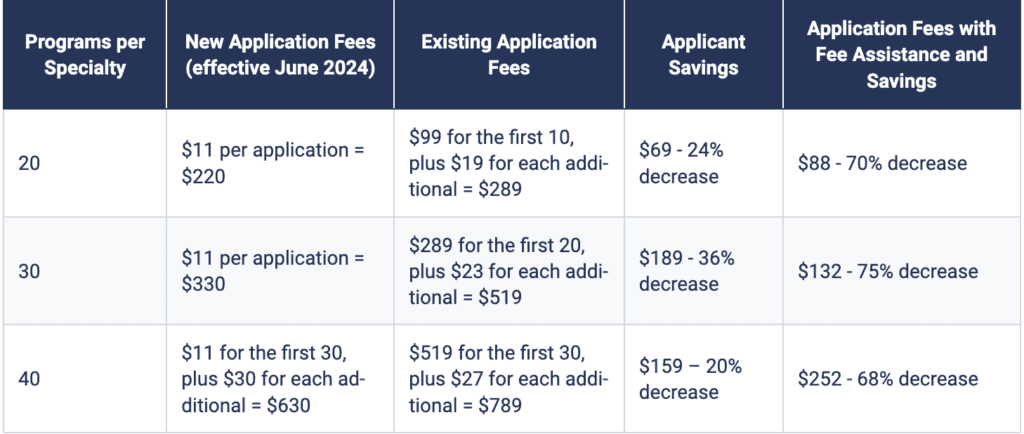Gear up for the upcoming ERAS application 2025 cycle with a deep dive into the latest updates for this season! There have been a few changes to the 2025 ERAS application, and while these aren’t as substantial as the 2024 updates, they’re still significant!
You’ll need to be familiar with them if you want to get the residency spot you deserve in the hypercompetitive world of graduate medical education. We’ll give you a heads up on all the ERAS application changes (including the residency application timeline for 2025), so you maximize your chances of matching into a program of your choice.
Before diving into the ERAS application 2025 updates, we’re going to start by briefly reviewing the changes made in 2024. As mentioned, they were substantial, so if you’re not familiar with them it’s important to understand what the changes were and why they were made, as they’re still in effect.

Want some practice answering the most common residency interview questions? Take this FREE interactive quiz that walks you through a mock interview, plus tips for answering each question!
How did the ERAS application change in 2024?
Briefly, here are three major updates to the MyERAS application in 2024:
1. Program Signaling
This allows you to express interest by submitting a limited number of official signals to your desired programs, which aids the programs in interview decisions and applicant selection. (Note: not all programs and specialties use signaling. More on this later.)
2. Impactful Experiences
This section gives you the opportunity to share and highlight up to three meaningful experiences that impacted the path of their career in medicine.
3. Geographic Preferences
You can now indicate preferences for specific locations (or urban/rural settings) and explain why you prefer a certain area in the US, whether it’s ties to family, spousal obligations, or hometown roots.
If you’d like to learn more, this blog post “What to Know About the New 2024 MyERAS Application” details the major changes to the 2024 ERAS application with a student and mentor dialogue!
What’s staying the same for 2025?
The lion’s share of the ERAS application itself is mostly unchanged from last year.
For the 2025 application cycle, the major changes are to a suite of tools and applications that the Association of American Medical Colleges (AAMC) and ERAS have collaborated on to improve.
You’ll still describe your meaningful experiences, upload your exam scores, your personal statement, CV, and letters of recommendation. Lastly, you may modify your application with signals and geographic preferences and, when ready, submit your completed ERAS for the programs to review.
What’s changing in 2025?
2025 Update #1: Residency Explorer Tool
ERAS and AAMC are updating and promoting the Residency Explorer tool, a collaborative product created by major medical organizations, including the AAMC, the National Resident Matching Program (NRMP), the American Medical Association (AMA), the ECFMG and others, to assist applicants to US residency programs.
Residency Explorer allows you to research programs in your specialty of interest and explore program characteristics based on information from previously matched applicants in those programs.
The tool boasts source-verified data from the reputable organizations listed above to help applicants involved in the transition to residency. Some benefits include providing a database for applicants to compare their qualifications with those of past applicants.
With the tool, you’ll be able to view how your USMLE or COMLEX scores, research experiences, and other qualifications compare to those of previously matched applicants to specific programs in order to gauge your own competitiveness, which can help influence the decision to apply to that particular program.
Furthermore, applicants are able to access detailed information about residency programs, including application requirements, interview details, and program characteristics, thereby helping them identify programs for which they are a good fit.
Ultimately, Residency Explorer is useful in helping you make an informed decision on which programs you’d like to apply to, bolstering your chances of matching with a suitable residency program.
Updates to the Residency Explorer tool this season allow you to do the following:
1. See how you compare with applicants who landed an interview.
You can compare yourself to past applicants who received interview invitations from the programs you’re researching.
Example: Jane, a US medical graduate with a USMLE Step 2 score of 255, uses the Residency Explorer tool to compare her score and qualifications with those of past applicants who matched into her desired internal medicine programs. She finds that her scores are above the average for several programs, which boosts her confidence in applying to them. And she can decide to rank her desired programs with confidence after interviewing at them.
2. Look at how program signals and geographic preferences impacted interview invitations.
You’ll be able to see interview invitation rates of applicants who signaled the program or had a geographic preference for where the program is located.
Example: Raj, an IMG, is interested in family medicine programs that have a history of accepting international graduates. He uses the tool to see which programs have high interview rates for applicants who used program signals. This information helps Raj prioritize programs that are more likely to consider his application favorably and offer him an opportunity to interview. (Here’s an updated list of programs and specialties that use signaling.)
Example: Emily prefers to stay in the Northeast due to family ties. She uses the Residency Explorer tool to filter programs based on geographic alignment and finds several programs that match her preference. This allows her to apply more strategically, focusing on programs in her desired location.
3. Find programs that match your interests.
See how a program aligns with your personal needs and career interests by selecting program characteristics important to your residency training.
Example: Carlos, an MD/PhD dual degree graduate who values research opportunities, uses the Residency Explorer tool to identify programs with interesting immunology research projects. By selecting program characteristics that are important to him, Carlos finds programs that offer extensive research opportunities in his field, helping him to match at a program that can further nurture his career goals.
4. Make sure you’re relying on original source-verified data.
View original, source-verified data from the six national organizations involved in the residency transition process. The Residency Explorer site offers the ONLY tool that includes original and verified data from these sources.
Example: Maria, an IMG, is concerned about the accuracy of the information she uses to make application decisions. The Residency Explorer tool provides her with source-verified data, including past applicants’ qualifications and match outcomes, giving her confidence in the reliability of the information and helping her make informed choices about where she should apply.
For IMGs like Maria, the Residency Explorer tool is particularly useful, as they often face additional challenges in the residency application process, such as visa issues and differences in medical education systems. The tool helps IMGs by:
- Highlighting programs that have historically accepted IMGs, increasing the likelihood of a successful match.
- Providing data on IMG interview rates and match outcomes, allowing for better application planning.
- Offering insights into program characteristics that are favorable to IMGs, such as support for visa sponsorship and international experience.
The bottom line is, whether you’re a US medical graduate or an IMG, this tool can help optimize your application strategy and chance of securing residency interviews.
2025 Update #2: Thalamus Core
Thalamus is an interview management platform, which allows applicants to schedule and manage multiple interviews. The AAMC works with Thalamus to improve the transition to residency. All Thalamus products are free for ERAS applicants and you can set up your Thalamus accounts beginning in July 2024.
After registering your ERAS token, you’ll receive a Thalamus account creation email, and after finalizing your Thalamus account, you’ll be ready to receive and respond to interview invitations after the start of the September residency cycle.
For the 2025 ERAS application season, all ERAS residency and fellowship programs will continue to receive complimentary access to Thalamus. Thalamus Core will replace ERAS Interview Scheduler as the main interview management platform for all applicants and programs.
The Thalamus suite of tools will allow program and applicant data and analytics reporting for programs of interest. An enhancement to the upcoming season will be the release of the AAMC Thalamus application program interface (API) in July 2024, which will allow for transfer of program data including applicant application data.
It’s anticipated that the vast majority of programs will leverage the Thalamus suite of products to manage their interviews for the 2025 ERAS season.
2025 Update #3: Fee Changes
Another change in 2025 is the new fee structure. According to AAMC, this fee change responds to feedback from the transition to residency community. The goal for the 2025 fee change is to lower the overall application costs and to simplify the cost structure for applicants.
The 2025 ERAS application fee is $11 for the first 1-30 programs you apply to, and $30 for each additional program. The cost is per specialty, and pricing resets with each additional specialty you apply to.
For example, if Josh applies to 30 emergency medicine programs, his total cost is [30 x $11] = $330.
If Yan applies to 43 internal medicine programs [(30 X $11) + (13 X $30)] + 7 radiology programs [7 X $11], his total cost is $797.
The chart below shows the comparison of fees for the 2024 and 2025 application cycles and the savings applicants will have for 2025.

Source: AAMC
What is the 2025 residency application timeline?
Now that we’ve reviewed all of the new changes on the 2025 ERAS application, when do you need to submit yours in order to be considered for the 2024-2025 residency cycle?
For US MDs and DOs, the residency application timeline for 2025 is as follows:
- June 5th, 2024: The 2025 ERAS season begins at 9 a.m. Eastern Time (ET).
- Sept. 4th, 2024: Residency applicants may begin submitting MyERAS applications to programs at 9 a.m. ET.
- Sept. 25th, 2024: Residency programs may begin reviewing MyERAS applications and Medical Student Performance Evaluations (MSPEs) in the Program Director’s Workstation (PDWS) at 9 a.m. ET.
- May 31st, 2025: ERAS season ends at 5 p.m. ET.
For International Medical Graduates (IMGs), the residency application timeline for 2025 is as follows:
- June 5th, 2024: 2025 ERAS season begins at 9 a.m. ET.
- June 26th, 2024: The Educational Commision for Foreign Medical Graduates (ECFMG) will distribute tokens to IMG residency applicants.
- Sept. 4th, 2024: Residency applicants may begin submitting MyERAS applications to programs at 9 a.m. ET.
- Sept. 25th, 2024: Residency programs may begin reviewing MyERAS applications in the PDWS at 9 a.m. ET.
- May 31st, 2025: 2025 ERAS season ends at 5 p.m. ET.
To stay on top of everything, follow along and make notes in the 2025 ERAS worksheet, which is designed to help applicants prepare for the 2025 MyERAS application.
Final Thoughts
As we reflect on the impactful updates to the 2025 MyERAS application, we can appreciate that these changes are implemented to streamline and enhance the application process for applicants and programs alike. After all, these updates are there for a reason!
For a full detailed description of the changes, please refer to the ERAS official website. Best of luck on your residency applications, and feel free to reach out to us if you need personalized support!
Looking for more (free!) content to help you through the residency application process? Check out these other posts on the Med School blog!




